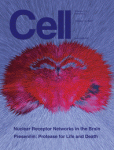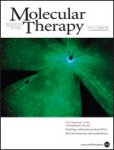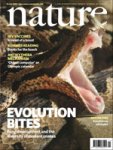Trương Xuân Đại
Senior Member
Table of Contents for Cell,
Volume 131, Issue 2. October 19, 2007
spacer
Analysis
From Bench to Business and Back Again
K. Wilan
Essay
Presenilin: Running with Scissors in the Membrane
D.J. Selkoe and M.S. Wolfe
Previews
A Backup DNA Repair Pathway Moves to the Forefront
A. Nussenzweig and M.C. Nussenzweig
When Two Is Better Than One
C.C. Babbitt, R. Haygood, and G.A. Wray
Retinoblastoma Teaches a New Lesson
H. te Riele
The Chromosomal Passenger Complex: One for All and All for One
S. Ruchaud, M. Carmena, and W.C. Earnshaw
How Mice Cope with Stressful Social Situations
S.E. Hyman
Taking Neural Crest Stem Cells to New Heights
E. Kokovay and S. Temple
Cordon-Bleu: A New Taste in Actin Nucleation
B. Winckler and D.A. Schafer
Review
Developmental Origin of Fat: Tracking Obesity to Its Source
S. Gesta, Y.-H. Tseng, and C.R. Kahn
SnapShot
Nuclear Transport
E.J. Tran, T.A. Bolger, and S.R. Wente
Articles
Regulation of Tumor Cell Mitochondrial Homeostasis by an Organelle-Specific Hsp90 Chaperone Network
B.H. Kang, J. Plescia, T. Dohi, J. Rosa, S.J. Doxsey, and D.C. Altieri
Molecular chaperones, especially members of the Hsp90 family, are thought to promote tumor cell survival, but this function is not well understood. Here, Kang et al. report that mitochondria of tumor cells, but not most normal tissues, contain Hsp90 and its related protein, TRAP-1. These molecules associate with Cyclophilin D - an immunophilin that normally initiates mitochondrial cell death - and inhibit its function. Furthermore, Hsp90 antagonists directed to mitochondria cause sudden collapse of mitochondrial function and selective tumor cell death. These organelle-specific antagonists may provide a new class of potent anticancer agents.
Structure of a Survivin-Borealin-INCENP Core Complex Reveals How Chromosomal Passengers Travel Together
A.A. Jeyaprakash, U.R. Klein, D. Lindner, J. Ebert, E.A. Nigg, and E. Conti
The chromosomal passenger complex (CPC), an essential regulator of mitosis, contains the kinase Aurora B and a regulatory complex (Survivin, Borealin, and INCENP). The CPC displays dynamic localization properties during cell division, and all three regulatory subunits are required for the spatial and temporal control of Aurora B activity. Jeyaprakash and colleagues solve the crystal structure of a minimal Survivin-Borealin-INCENP complex and use structure-based mutants to reveal that the association of all three subunits creates a composite molecular surface that bears the conserved residues required for localization. Thus, the regulatory core of the CPC functions as a single structural unit.
Recycling of Eukaryotic Posttermination Ribosomal Complexes
A.V. Pisarev, C.U.T. Hellen, and T.V. Pestova
To participate in multiple rounds of translation, ribosomes have to be recycled after translation termination. In prokaryotes, recycling requires ribosome recycling factor RRF. Eukaryotes lack an RRF homolog, and their recycling mechanism has been unknown. Pisarev et al. reconstitute eukaryotic recycling in vitro and show that it can be promoted by translation initiation factors. eIF3 plays the principal role in splitting posttermination complexes into 60S subunits and mRNA/tRNA-containing 40S subunits. Next, eIF1 mediates release of tRNA and eIF3j ensures subsequent mRNA dissociation. This study provides an unexpected function for translation initiation factors in ribosome recycling.
The Structural Basis for the Large Powerstroke of Myosin VI
J. Ménétrey, P. Llinas, M. Mukherjea, H.L. Sweeney, and A. Houdusse
Myosin VI moves along actin filaments in the opposite direction than other myosin motors and has a large step size (powerstroke). These properties stem from unique structural inserts within myosin VI. Now, Menetrey and colleagues solve the crystal structure of myosin VI in a state that represents the starting point for movement (pre-powerstroke). Myosin VI adopts a pre-powerstroke state in which the domain that positions the lever arm is rearranged compared to its position at the end of the powerstroke. These findings explain the directionality and large powerstroke of myosin VI.
RSUME, a Small RWD-Containing Protein, Enhances SUMO Conjugation and Stabilizes HIF-1α during Hypoxia
A. Carbia-Nagashima, J. Gerez, C. Perez-Castro, M. Paez-Pereda, S. Silberstein, G.K. Stalla, F. Holsboer, and E. Arzt
Conjugation of SUMO to various proteins regulates diverse cellular functions. Carbia-Nagashima et al. identify a protein RSUME that is induced by hypoxia in brain tumors. RSUME enhances the sumoylation of proteins including IκB and HIF-1α, which inhibits NF-κB activity and stabilizes HIF-1α, respectively. RSUME forms a heterodimer with the SUMO conjugase Ubc9 and enhances Ubc9 activity. These findings point to a central role of RSUME in potentiating sumoylation and hence in influencing critical regulatory pathways such as hypoxia and NF-κB signaling.
Self-Renewing Osteoprogenitors in Bone Marrow Sinusoids Can Organize a Hematopoietic Microenvironment
B. Sacchetti, A. Funari, S. Michienzi, S. Di Cesare, S. Piersanti, I. Saggio, E. Tagliafico, S. Ferrari, P.G. Robey, M. Riminucci, and P. Bianco
The identity and self-renewal capacity of the skeletal stem/progenitor cells in the bone marrow has long remained elusive. Here, Sacchetti et al. identify subendothelial, adventitial cells in bone marrow sinusoids as clonogenic osteoprogenitors. When explanted, these cells can generate bone and self-renew upon heterotopic transplantation in vivo. These transplanted cells also establish, through dynamic interactions with developing sinusoids, the hematopoietic microenvironment at heterotopic sites. Thus, subendothelial, adventitial cells of bone marrow sinusoids can act as organizers of the hematopoietic microenvironment.
Cordon-Bleu Is an Actin Nucleation Factor and Controls Neuronal Morphology
R. Ahuja, R. Pinyol, N. Reichenbach, L. Custer, J. Klingensmith, M.M. Kessels, and B. Qualmann
Despite the numerous crucial functions of actin filaments and the variety of different cellular actin structures formed, there are only a small number of factors known to nucleate filament formation. Here, Ahuja et al. describe the discovery and detailed characterization of a new type of nucleator, Cordon-bleu, which promotes formation of nonbundled, unbranched filaments and appears to be important for neuronal morphology. The results suggest that a minimal assembly of three actin monomers in crossfilament orientation is needed to kick-start spontaneous actin filament polymerization.
v-SNARE Actions during Ca2+ -Triggered Exocytosis
J. Kesavan, M. Borisovska, and D. Bruns
SNARE proteins mediate membrane fusion in various trafficking pathways. However, the degree to which SNAREs provide the force for vesicle fusion remains poorly understood. Using a combination of high-resolution techniques, Kesavan et al. examine calcium-dependent exocytosis in mouse chromaffin cells at the millisecond timescale. The authors show that the execution of pre- and postfusional steps during exocytosis depends on a short molecular distance between the SNARE domain and the transmembrane anchor of the vesicular SNARE protein synaptobrevin II. Thus vesicular SNARE proteins drive membrane fusion and continuous molecular "pulling" by SNAREs guide the vesicle through the consecutive stages of exocytosis.
Glia-like Stem Cells Sustain Physiologic Neurogenesis in the Adult Mammalian Carotid Body
R. Pardal, P. Ortega-Sáenz, R. Durán, and J. López-Barneo
Neurogenesis occurs in the adult mammalian brain, but whether neural stem cells exist in the peripheral nervous system is unknown. Pardal et al. now identify stem cells in the adult carotid body, an oxygen-sensing organ. Unexpectedly, these stem cells are glia-like cells, which were believed to have only a supportive role. Activated by low blood oxygen, these cells produce progenitors that differentiate into neuron-like glomus cells and produce dopamine and growth factors in vitro. Thus neurogenesis can occur in the adult peripheral nervous system and stem cell-derived glomus cells may be useful for cell therapy against Parkinson's disease.
Differentiated Horizontal Interneurons Clonally Expand to Form Metastatic Retinoblastoma in Mice
I. Ajioka, R.A.P. Martins, I.T. Bayazitov, S. Donovan, D.A. Johnson, S. Frase, S. Cicero, K. Boyd, S.S. Zakharenko, and M.A. Dyer
It is commonly believed that cell-cycle exit must precede differentiation, and that terminally differentiated cells do not proliferate. This principle extends to cancer as differentiated tumors are less aggressive than their undifferentiated counterparts. Now, Ajioka et al. show that a postmitotic differentiated neuron re-enters the cell cycle and clonally expands while maintaining all of its molecular and morphological features including neurites and synapses. Studying the mouse retina, the authors find that interneurons rapidly expand and form highly differentiated, yet extremely aggressive, retinoblastoma. These provocative findings provide a fresh look on the relationship between differentiation and proliferation during tumorigenesis.
Molecular Adaptations Underlying Susceptibility and Resistance to Social Defeat in Brain Reward Regions
V. Krishnan, M.-H. Han, D.L. Graham, O. Berton, W. Renthal, S.J. Russo, Q. LaPlant, A. Graham, M. Lutter, D.C. Lagace, S. Ghose, R. Reister, P. Tannous, T.A. Green, R.L. Neve, S. Chakravarty, A. Kumar, A.J. Eisch, D.W. Self, F.S. Lee, C.A. Tamminga, D.C. Cooper, H.K. Gershenfeld, and E.J. Nestler
Stress can precipitate conditions like depression in some individuals but not others, and mechanisms underlying these variations are poorly understood. Krishnan et al. investigate the adaptations in the brain that distinguish mice that are susceptible to a social stress (social defeat) from those that are resistant. Vulnerability is mediated by enhanced release of the growth factor BDNF in two limbic structures that mediate brain reward. Thus brain reward circuits are important in the susceptibility and resistance to stress, and these adaptations in mice may help to understand depression and resilience in humans.
Resource
Systematic Gene Expression Mapping Clusters Nuclear Receptors According to Their Function in the Brain
F. Gofflot, N. Chartoire, L. Vasseur, S. Heikkinen, D. Dembele, J. Le Merrer, and J. Auwerx
Nuclear receptors (NRs) are transcription factors that operate at the interface between genes and the environment. Although most NRs are present in the central nervous system, little is known about their roles in behavior and in neurological and psychiatric disorders. Gofflot et al. now provide a systematic quantitative and anatomical expression atlas of the entire NR gene family in 104 regions of the adult mouse brain at cellular resolution. The data are organized in an interactive database called MousePat. Using the MousePat resource, NR expression patterns can be clustered into anatomical and regulatory networks that indicate the role of NRs in specialized brain functions.
Volume 131, Issue 2. October 19, 2007
spacer
Analysis
From Bench to Business and Back Again
K. Wilan
Essay
Presenilin: Running with Scissors in the Membrane
D.J. Selkoe and M.S. Wolfe
Previews
A Backup DNA Repair Pathway Moves to the Forefront
A. Nussenzweig and M.C. Nussenzweig
When Two Is Better Than One
C.C. Babbitt, R. Haygood, and G.A. Wray
Retinoblastoma Teaches a New Lesson
H. te Riele
The Chromosomal Passenger Complex: One for All and All for One
S. Ruchaud, M. Carmena, and W.C. Earnshaw
How Mice Cope with Stressful Social Situations
S.E. Hyman
Taking Neural Crest Stem Cells to New Heights
E. Kokovay and S. Temple
Cordon-Bleu: A New Taste in Actin Nucleation
B. Winckler and D.A. Schafer
Review
Developmental Origin of Fat: Tracking Obesity to Its Source
S. Gesta, Y.-H. Tseng, and C.R. Kahn
SnapShot
Nuclear Transport
E.J. Tran, T.A. Bolger, and S.R. Wente
Articles
Regulation of Tumor Cell Mitochondrial Homeostasis by an Organelle-Specific Hsp90 Chaperone Network
B.H. Kang, J. Plescia, T. Dohi, J. Rosa, S.J. Doxsey, and D.C. Altieri
Molecular chaperones, especially members of the Hsp90 family, are thought to promote tumor cell survival, but this function is not well understood. Here, Kang et al. report that mitochondria of tumor cells, but not most normal tissues, contain Hsp90 and its related protein, TRAP-1. These molecules associate with Cyclophilin D - an immunophilin that normally initiates mitochondrial cell death - and inhibit its function. Furthermore, Hsp90 antagonists directed to mitochondria cause sudden collapse of mitochondrial function and selective tumor cell death. These organelle-specific antagonists may provide a new class of potent anticancer agents.
Structure of a Survivin-Borealin-INCENP Core Complex Reveals How Chromosomal Passengers Travel Together
A.A. Jeyaprakash, U.R. Klein, D. Lindner, J. Ebert, E.A. Nigg, and E. Conti
The chromosomal passenger complex (CPC), an essential regulator of mitosis, contains the kinase Aurora B and a regulatory complex (Survivin, Borealin, and INCENP). The CPC displays dynamic localization properties during cell division, and all three regulatory subunits are required for the spatial and temporal control of Aurora B activity. Jeyaprakash and colleagues solve the crystal structure of a minimal Survivin-Borealin-INCENP complex and use structure-based mutants to reveal that the association of all three subunits creates a composite molecular surface that bears the conserved residues required for localization. Thus, the regulatory core of the CPC functions as a single structural unit.
Recycling of Eukaryotic Posttermination Ribosomal Complexes
A.V. Pisarev, C.U.T. Hellen, and T.V. Pestova
To participate in multiple rounds of translation, ribosomes have to be recycled after translation termination. In prokaryotes, recycling requires ribosome recycling factor RRF. Eukaryotes lack an RRF homolog, and their recycling mechanism has been unknown. Pisarev et al. reconstitute eukaryotic recycling in vitro and show that it can be promoted by translation initiation factors. eIF3 plays the principal role in splitting posttermination complexes into 60S subunits and mRNA/tRNA-containing 40S subunits. Next, eIF1 mediates release of tRNA and eIF3j ensures subsequent mRNA dissociation. This study provides an unexpected function for translation initiation factors in ribosome recycling.
The Structural Basis for the Large Powerstroke of Myosin VI
J. Ménétrey, P. Llinas, M. Mukherjea, H.L. Sweeney, and A. Houdusse
Myosin VI moves along actin filaments in the opposite direction than other myosin motors and has a large step size (powerstroke). These properties stem from unique structural inserts within myosin VI. Now, Menetrey and colleagues solve the crystal structure of myosin VI in a state that represents the starting point for movement (pre-powerstroke). Myosin VI adopts a pre-powerstroke state in which the domain that positions the lever arm is rearranged compared to its position at the end of the powerstroke. These findings explain the directionality and large powerstroke of myosin VI.
RSUME, a Small RWD-Containing Protein, Enhances SUMO Conjugation and Stabilizes HIF-1α during Hypoxia
A. Carbia-Nagashima, J. Gerez, C. Perez-Castro, M. Paez-Pereda, S. Silberstein, G.K. Stalla, F. Holsboer, and E. Arzt
Conjugation of SUMO to various proteins regulates diverse cellular functions. Carbia-Nagashima et al. identify a protein RSUME that is induced by hypoxia in brain tumors. RSUME enhances the sumoylation of proteins including IκB and HIF-1α, which inhibits NF-κB activity and stabilizes HIF-1α, respectively. RSUME forms a heterodimer with the SUMO conjugase Ubc9 and enhances Ubc9 activity. These findings point to a central role of RSUME in potentiating sumoylation and hence in influencing critical regulatory pathways such as hypoxia and NF-κB signaling.
Self-Renewing Osteoprogenitors in Bone Marrow Sinusoids Can Organize a Hematopoietic Microenvironment
B. Sacchetti, A. Funari, S. Michienzi, S. Di Cesare, S. Piersanti, I. Saggio, E. Tagliafico, S. Ferrari, P.G. Robey, M. Riminucci, and P. Bianco
The identity and self-renewal capacity of the skeletal stem/progenitor cells in the bone marrow has long remained elusive. Here, Sacchetti et al. identify subendothelial, adventitial cells in bone marrow sinusoids as clonogenic osteoprogenitors. When explanted, these cells can generate bone and self-renew upon heterotopic transplantation in vivo. These transplanted cells also establish, through dynamic interactions with developing sinusoids, the hematopoietic microenvironment at heterotopic sites. Thus, subendothelial, adventitial cells of bone marrow sinusoids can act as organizers of the hematopoietic microenvironment.
Cordon-Bleu Is an Actin Nucleation Factor and Controls Neuronal Morphology
R. Ahuja, R. Pinyol, N. Reichenbach, L. Custer, J. Klingensmith, M.M. Kessels, and B. Qualmann
Despite the numerous crucial functions of actin filaments and the variety of different cellular actin structures formed, there are only a small number of factors known to nucleate filament formation. Here, Ahuja et al. describe the discovery and detailed characterization of a new type of nucleator, Cordon-bleu, which promotes formation of nonbundled, unbranched filaments and appears to be important for neuronal morphology. The results suggest that a minimal assembly of three actin monomers in crossfilament orientation is needed to kick-start spontaneous actin filament polymerization.
v-SNARE Actions during Ca2+ -Triggered Exocytosis
J. Kesavan, M. Borisovska, and D. Bruns
SNARE proteins mediate membrane fusion in various trafficking pathways. However, the degree to which SNAREs provide the force for vesicle fusion remains poorly understood. Using a combination of high-resolution techniques, Kesavan et al. examine calcium-dependent exocytosis in mouse chromaffin cells at the millisecond timescale. The authors show that the execution of pre- and postfusional steps during exocytosis depends on a short molecular distance between the SNARE domain and the transmembrane anchor of the vesicular SNARE protein synaptobrevin II. Thus vesicular SNARE proteins drive membrane fusion and continuous molecular "pulling" by SNAREs guide the vesicle through the consecutive stages of exocytosis.
Glia-like Stem Cells Sustain Physiologic Neurogenesis in the Adult Mammalian Carotid Body
R. Pardal, P. Ortega-Sáenz, R. Durán, and J. López-Barneo
Neurogenesis occurs in the adult mammalian brain, but whether neural stem cells exist in the peripheral nervous system is unknown. Pardal et al. now identify stem cells in the adult carotid body, an oxygen-sensing organ. Unexpectedly, these stem cells are glia-like cells, which were believed to have only a supportive role. Activated by low blood oxygen, these cells produce progenitors that differentiate into neuron-like glomus cells and produce dopamine and growth factors in vitro. Thus neurogenesis can occur in the adult peripheral nervous system and stem cell-derived glomus cells may be useful for cell therapy against Parkinson's disease.
Differentiated Horizontal Interneurons Clonally Expand to Form Metastatic Retinoblastoma in Mice
I. Ajioka, R.A.P. Martins, I.T. Bayazitov, S. Donovan, D.A. Johnson, S. Frase, S. Cicero, K. Boyd, S.S. Zakharenko, and M.A. Dyer
It is commonly believed that cell-cycle exit must precede differentiation, and that terminally differentiated cells do not proliferate. This principle extends to cancer as differentiated tumors are less aggressive than their undifferentiated counterparts. Now, Ajioka et al. show that a postmitotic differentiated neuron re-enters the cell cycle and clonally expands while maintaining all of its molecular and morphological features including neurites and synapses. Studying the mouse retina, the authors find that interneurons rapidly expand and form highly differentiated, yet extremely aggressive, retinoblastoma. These provocative findings provide a fresh look on the relationship between differentiation and proliferation during tumorigenesis.
Molecular Adaptations Underlying Susceptibility and Resistance to Social Defeat in Brain Reward Regions
V. Krishnan, M.-H. Han, D.L. Graham, O. Berton, W. Renthal, S.J. Russo, Q. LaPlant, A. Graham, M. Lutter, D.C. Lagace, S. Ghose, R. Reister, P. Tannous, T.A. Green, R.L. Neve, S. Chakravarty, A. Kumar, A.J. Eisch, D.W. Self, F.S. Lee, C.A. Tamminga, D.C. Cooper, H.K. Gershenfeld, and E.J. Nestler
Stress can precipitate conditions like depression in some individuals but not others, and mechanisms underlying these variations are poorly understood. Krishnan et al. investigate the adaptations in the brain that distinguish mice that are susceptible to a social stress (social defeat) from those that are resistant. Vulnerability is mediated by enhanced release of the growth factor BDNF in two limbic structures that mediate brain reward. Thus brain reward circuits are important in the susceptibility and resistance to stress, and these adaptations in mice may help to understand depression and resilience in humans.
Resource
Systematic Gene Expression Mapping Clusters Nuclear Receptors According to Their Function in the Brain
F. Gofflot, N. Chartoire, L. Vasseur, S. Heikkinen, D. Dembele, J. Le Merrer, and J. Auwerx
Nuclear receptors (NRs) are transcription factors that operate at the interface between genes and the environment. Although most NRs are present in the central nervous system, little is known about their roles in behavior and in neurological and psychiatric disorders. Gofflot et al. now provide a systematic quantitative and anatomical expression atlas of the entire NR gene family in 104 regions of the adult mouse brain at cellular resolution. The data are organized in an interactive database called MousePat. Using the MousePat resource, NR expression patterns can be clustered into anatomical and regulatory networks that indicate the role of NRs in specialized brain functions.







